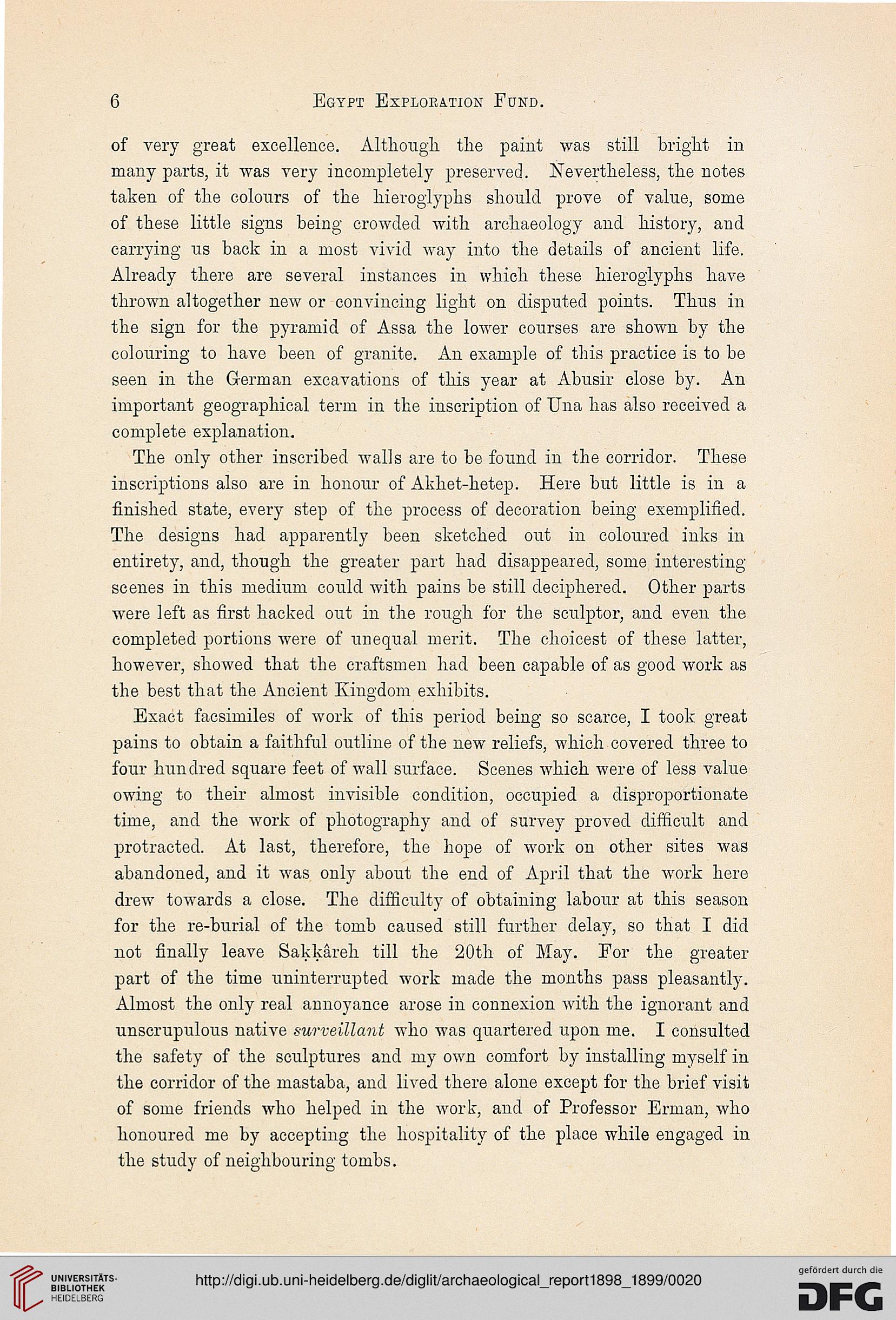6
Egypt Exploration Fund.
of very great excellence. Although the paint was still bright in
many parts, it was very incompletely preserved. Nevertheless, the notes
taken of the colours of the hieroglyphs should prove of value, some
of these little signs being crowded with archaeology and history, and
carrying us back in a most vivid way into the details of ancient life.
Already there are several instances in which these hieroglyphs have
thrown altogether new or convincing light on disputed points. Thus in
the sign for the pyramid of Assa the lower courses are shown by the
colouring to have been of granite. An example of this practice is to be
seen in the German excavations of this year at Abusir close by. An
important geographical term in the inscription of Una has also received a
complete explanation.
The only other inscribed walls are to be found in the corridor. These
inscriptions also are in honour of Akhet-hetep. Here but little is in a
finished state, every step of the process of decoration being exemplified.
The designs had apparently been sketched out in coloured inks in
entirety, and, though the greater part had disappeared, some interesting
scenes in this medium could with pains be still deciphered. Other parts
were left as first hacked out in the rough for the sculptor, and even the
completed portions were of unequal merit. The choicest of these latter,
however, showed that the craftsmen had been capable of as good work as
the best that the Ancient Kingdom exhibits.
Exact facsimiles of work of this period being so scarce, I took great
pains to obtain a faithful outline of the new reliefs, which covered three to
four hundred square feet of wall surface. Scenes which were of less value
owing to their almost invisible condition, occupied a disproportionate
time, and the work of photography and of survey proved difficult and
protracted. At last, therefore, the hope of work on other sites was
abandoned, and it was only about the end of April that the work here
drew towards a close. The difficulty of obtaining labour at this season
for the re-burial of the tomb caused still further delay, so that I did
not finally leave Sakkareh till the 20th of May. For the greater
part of the time uninterrupted work made the months pass pleasantly.
Almost the only real annoyance arose in connexion with the ignorant and
unscrupulous native surveillant who was quartered upon me. I consulted
the safety of the sculptures and my own comfort by installing myself in
the corridor of the mastaba, and lived there alone except for the brief visit
of some friends who helped in the work, and of Professor Erman, who
honoured me by accepting the hospitality of the place while engaged in
the study of neighbouring tombs.
Egypt Exploration Fund.
of very great excellence. Although the paint was still bright in
many parts, it was very incompletely preserved. Nevertheless, the notes
taken of the colours of the hieroglyphs should prove of value, some
of these little signs being crowded with archaeology and history, and
carrying us back in a most vivid way into the details of ancient life.
Already there are several instances in which these hieroglyphs have
thrown altogether new or convincing light on disputed points. Thus in
the sign for the pyramid of Assa the lower courses are shown by the
colouring to have been of granite. An example of this practice is to be
seen in the German excavations of this year at Abusir close by. An
important geographical term in the inscription of Una has also received a
complete explanation.
The only other inscribed walls are to be found in the corridor. These
inscriptions also are in honour of Akhet-hetep. Here but little is in a
finished state, every step of the process of decoration being exemplified.
The designs had apparently been sketched out in coloured inks in
entirety, and, though the greater part had disappeared, some interesting
scenes in this medium could with pains be still deciphered. Other parts
were left as first hacked out in the rough for the sculptor, and even the
completed portions were of unequal merit. The choicest of these latter,
however, showed that the craftsmen had been capable of as good work as
the best that the Ancient Kingdom exhibits.
Exact facsimiles of work of this period being so scarce, I took great
pains to obtain a faithful outline of the new reliefs, which covered three to
four hundred square feet of wall surface. Scenes which were of less value
owing to their almost invisible condition, occupied a disproportionate
time, and the work of photography and of survey proved difficult and
protracted. At last, therefore, the hope of work on other sites was
abandoned, and it was only about the end of April that the work here
drew towards a close. The difficulty of obtaining labour at this season
for the re-burial of the tomb caused still further delay, so that I did
not finally leave Sakkareh till the 20th of May. For the greater
part of the time uninterrupted work made the months pass pleasantly.
Almost the only real annoyance arose in connexion with the ignorant and
unscrupulous native surveillant who was quartered upon me. I consulted
the safety of the sculptures and my own comfort by installing myself in
the corridor of the mastaba, and lived there alone except for the brief visit
of some friends who helped in the work, and of Professor Erman, who
honoured me by accepting the hospitality of the place while engaged in
the study of neighbouring tombs.





